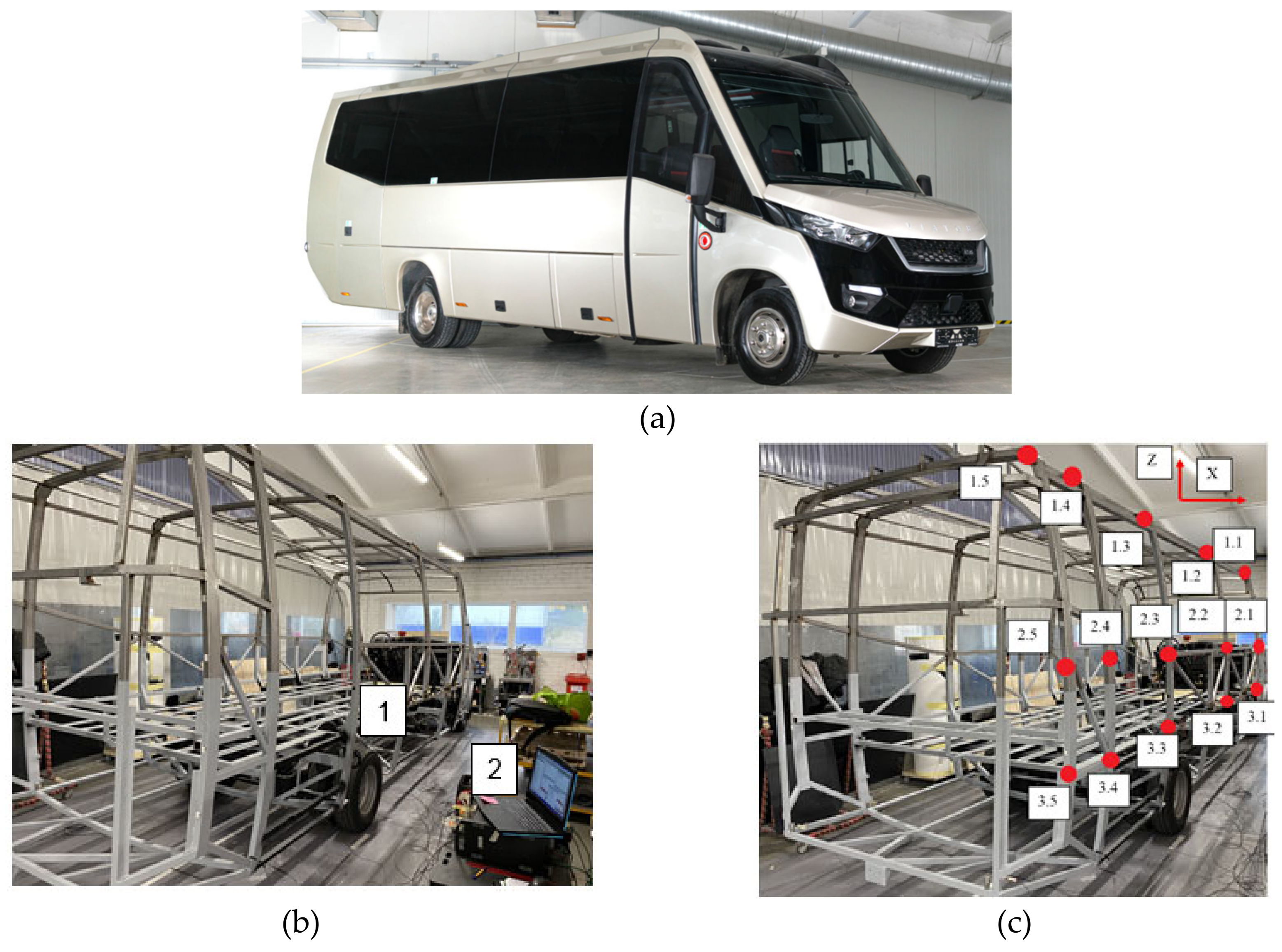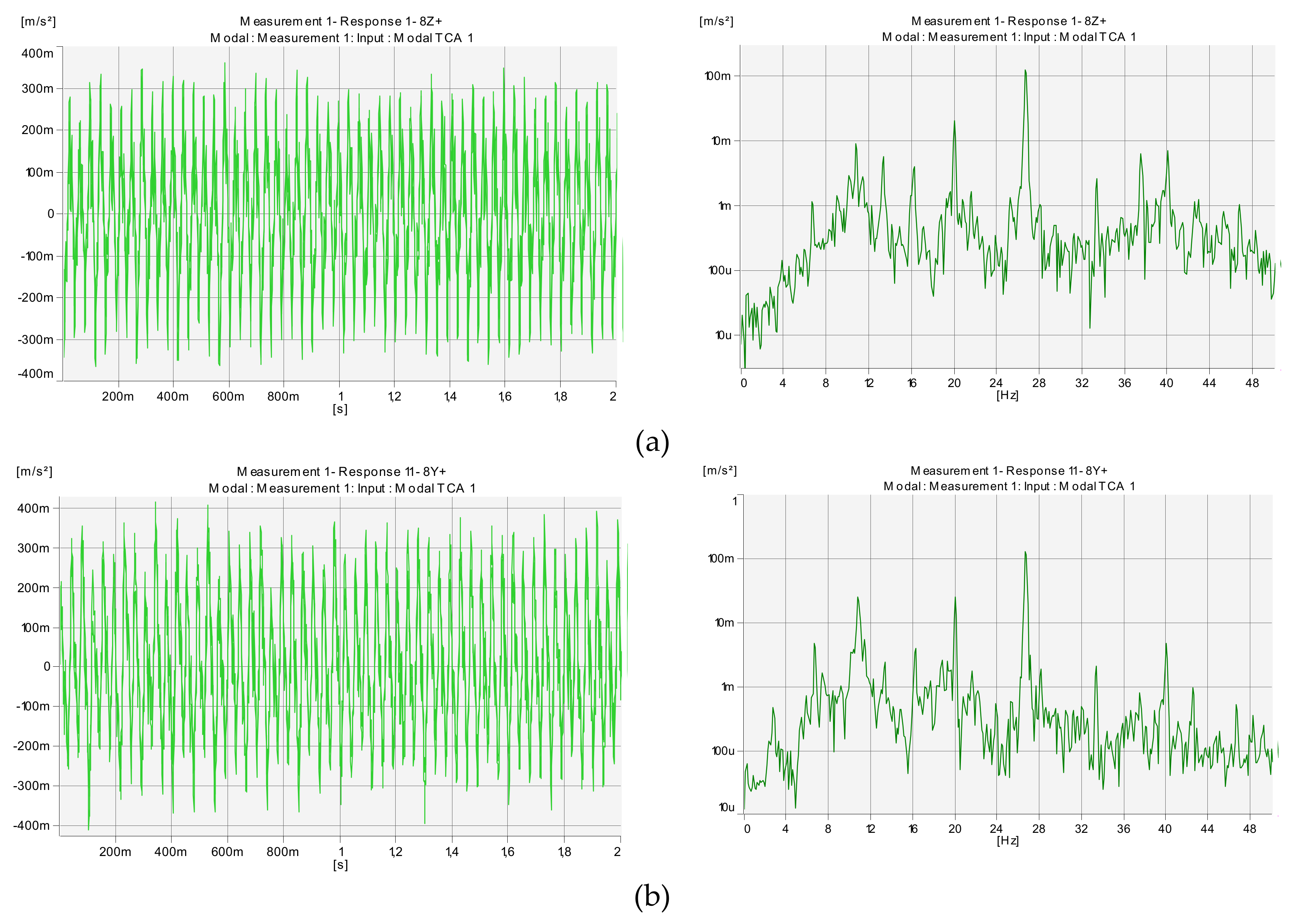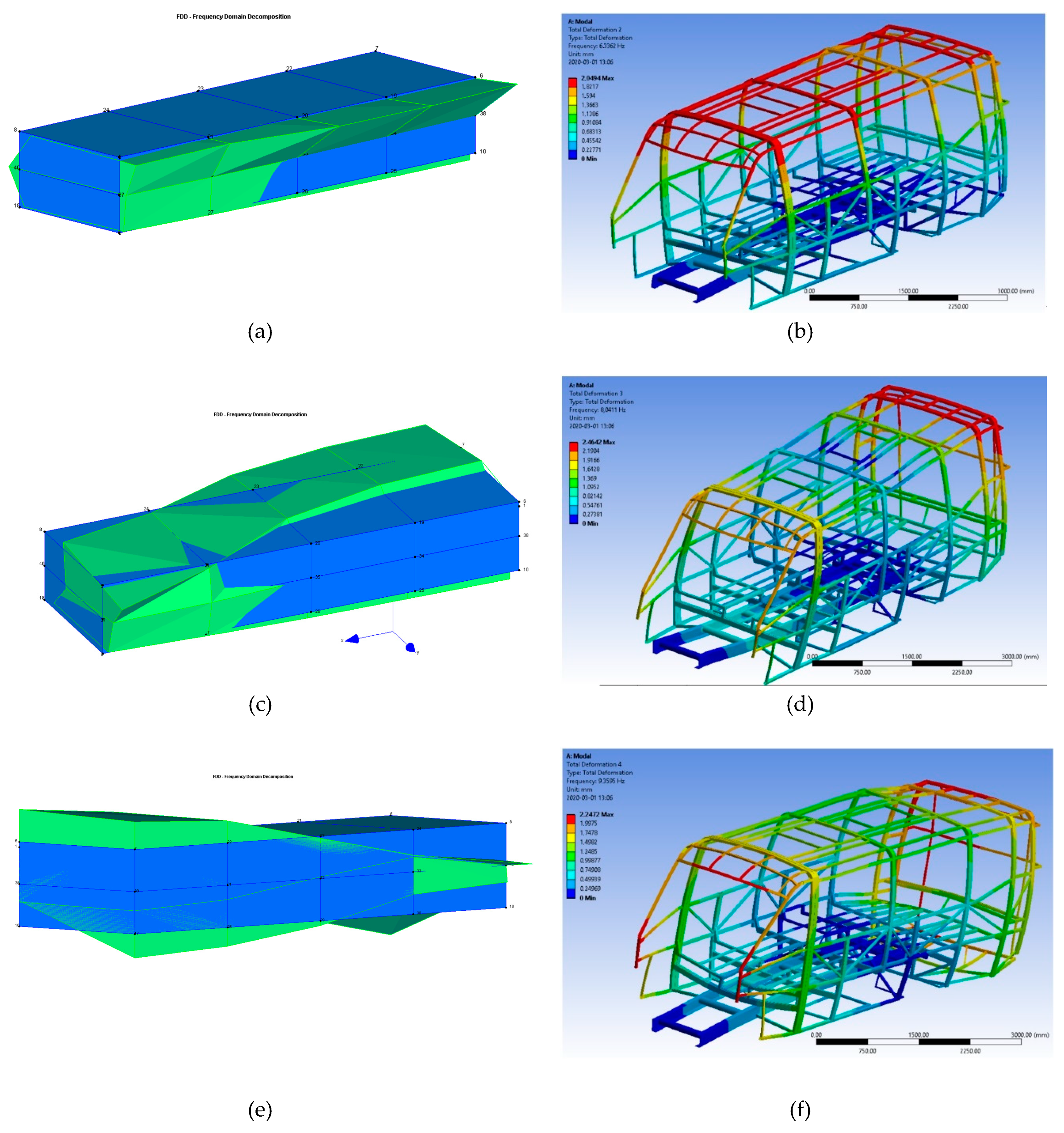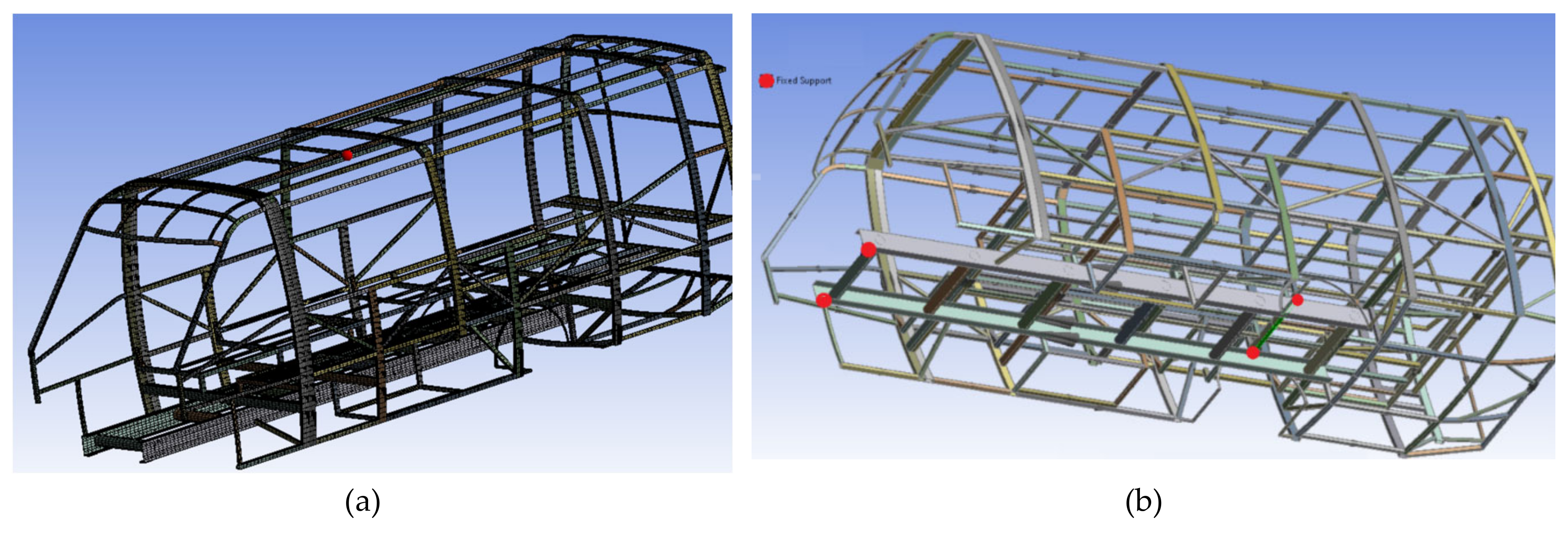The Usage of Alternative Materials to Optimize Bus Frame Structure
Abstract
1. Introduction
2. Research Object and Experimental Modal Analysis
3. Numerical Analysis of the Modified Bus Body
4. Conclusions
Author Contributions
Funding
Conflicts of Interest
References
- Helms, H.; Lambrecht, U. LCA Case Studies The Potential Contribution of Light-Weighting to Reduce Transport Energy Consumption. Int. J. Life Cycle Assess 2007, 12, 58–64. [Google Scholar]
- Maghrour Zefreh, M.; Torok, A. Theoretical Comparison of the Effects of Different Traffic Conditions on Urban Road Traffic Noise. J. Adv. Transp. 2018, 2018, 1–11. [Google Scholar] [CrossRef]
- Younger, M.; Morrow-Almeida, H.R.; Vindigni, S.M.; Dannenberg, A.L. The Built Environment, Climate Change, and Health. Am. J. Prev. Med. 2008, 35, 517–526. [Google Scholar] [CrossRef] [PubMed]
- Margaritis, D.; Anagnostopoulou, A.; Tromaras, A.; Boile, M. Electric commercial vehicles: Practical perspectives and future research directions. Res. Transp. Bus. Manag. 2016, 18, 4–10. [Google Scholar] [CrossRef]
- Heutel, G.; Ruhm, C.J. Air Pollution and Procyclical Mortality. J. Assoc. Environ. Resour. Econ. 2016, 3, 667–706. [Google Scholar] [CrossRef]
- Greenhouse Gas Emission Statistics-emission Inventories. Available online: https://ec.europa.eu/eurostat/statistics-explained/pdfscache/1180.pdf (accessed on 18 May 2020).
- Rimkus, A.; Pukalskas, S.; Matijošius, J.; Sokolovskij, E. Betterment of ecological parameters of a diesel engine using Brown‘s gas. J. Environ. Eng. Landsc. Manag. 2012, 21, 133–140. [Google Scholar] [CrossRef]
- Wenlong, S.; Xiaokai, C.; Lu, W. Analysis of Energy Saving and Emission Reduction of Vehicles Using Light Weight Materials. Energy Procedia 2016, 88, 889–893. [Google Scholar] [CrossRef]
- Yuce, C.; Karpat, F.; Yavuz, N.; Sendeniz, G. A Case Study: Designing for Sustainability and Reliability in an Automotive Seat Structure. Sustainability 2014, 6, 4608–4631. [Google Scholar] [CrossRef]
- Kilikevičienė, K.; Kačianauskas, R.; Kilikevičius, A.; Maknickas, A.; Matijošius, J.; Rimkus, A.; Vainorius, D. Experimental investigation of acoustic agglomeration of diesel engine exhaust particles using new created acoustic chamber. Powder Technol. 2019, 360, 421–429. [Google Scholar] [CrossRef]
- Gutarevych, Y.; Mateichyk, V.; Matijošius, J.; Rimkus, A.; Gritsuk, I.; Syrota, O.; Shuba, Y. Improving Fuel Economy of Spark Ignition Engines Applying the Combined Method of Power Regulation. Energies 2020, 13, 1076. [Google Scholar] [CrossRef]
- Hunicz, J.; Matijošius, J.; Rimkus, A.; Kilikevičius, A.; Kordos, P.; Mikulski, M. Efficient hydrotreated vegetable oil combustion under partially premixed conditions with heavy exhaust gas recirculation. Fuel 2020, 268, 117350. [Google Scholar] [CrossRef]
- Liu, Q.; Lin, Y.; Zong, Z.; Sun, G.; Li, Q. Lightweight design of carbon twill weave fabric composite body structure for electric vehicle. Compos. Struct. 2013, 97, 231–238. [Google Scholar] [CrossRef]
- Duan, S.; Yang, X.; Tao, Y.; Mo, F.; Xiao, Z.; Wei, K. Experimental and numerical investigation of Long Glass Fiber Reinforced Polypropylene composite and application in automobile components. Transport 2017, 33, 1–9. [Google Scholar] [CrossRef]
- Joost, W.J. Reducing Vehicle Weight and Improving U.S. Energy Efficiency Using Integrated Computational Materials Engineering. JOM 2012, 64, 1032–1038. [Google Scholar] [CrossRef]
- Andrzejczak, K.; Młyńczak, M.; Selech, J. Poisson-distributed failures in the predicting of the cost of corrective maintenance. Eksploat. Niezawodn. Maint. Reliab. 2018, 20, 602–609. [Google Scholar] [CrossRef]
- Rebaïne, F.; Bouazara, M.; Rahem, A.; St-Georges, L. Static and Vibration Analysis of an Aluminium and Steel Bus Frame. World J. Mech. 2018, 08, 112–135. [Google Scholar] [CrossRef][Green Version]
- Sathishkumar, P.; Wang, R.; Yang, L.; Thiyagarajan, J. Trajectory control for tire burst vehicle using the standalone and roll interconnected active suspensions with safety-comfort control strategy. Mech. Syst. Signal Process. 2020, 142, 106776. [Google Scholar] [CrossRef]
- Mansfield, N.; Naddeo, A.; Frohriep, S.; Vink, P. Integrating and applying models of comfort. Appl. Ergon. 2020, 82, 102917. [Google Scholar] [CrossRef]
- Xu, L.; Xin, L.; Yu, Z.; Zhu, Z. Construction of a dynamic model for the interaction between the versatile tracks and a vehicle. Eng. Struct. 2020, 206, 110067. [Google Scholar] [CrossRef]
- Xu, L.; Zhao, Y.; Li, Z.; Shi, C.; Yu, Z. Three-dimensional vehicle-ballasted track-subgrade interaction: Model construction and numerical analysis. Appl. Math. Model. 2020. [Google Scholar] [CrossRef]
- Zhi, P.; Li, Y.; Chen, B.; Shi, S. Bounds-based structure reliability analysis of bogie frame under variable load cases. Eng. Fail. Anal. 2020, 114, 104541. [Google Scholar] [CrossRef]
- Brumercik, F.; Lukac, M.; Caban, J.; Krzysiak, Z.; Glowacz, A. Comparison of Selected Parameters of a Planetary Gearbox with Involute and Convex-Concave Teeth Flank Profiles. Appl. Sci. 2020, 10, 1417. [Google Scholar] [CrossRef]
- Yan, J.-B.; Zhang, W. Numerical analysis on steel-concrete-steel sandwich plates by damage plasticity model: From materials to structures. Constr. Build. Mater. 2017, 149, 801–815. [Google Scholar] [CrossRef]
- KilikevičIenė, K.; Skeivalas, J.; KilikevičIus, A.; PečEliūNas, R.; Bureika, G. The analysis of bus air spring condition influence upon the vibration signals at bus frame. Eksploat. Niezawodn. Maint. Reliab. 2015, 17, 463–469. [Google Scholar] [CrossRef]
- Kilikevičius, A.; Kilikevičienė, K.; Matijošius, J. Investigation of Drivers’ Comfort Factors Influencing Urban Traffic Safety. In Vision Zero for Sustainable Road Safety in Baltic Sea Region, Lecture Notes in Intelligent Transportation and Infrastructure; Varhelyi, A., Žuraulis, V., Prentkovskis, O., Eds.; Springer International Publishing: Berlin/Heidelberg, Germany, 2020; pp. 159–165. ISBN 978-3-030-22374-8. [Google Scholar]
- Kilikevičius, A.; Kilikevičienė, K.; Fursenko, A.; Matijošius, J. The Analysis of Vibration Signals of Critical Points of the Bus Body Frame. Period. Polytech. Transp. Eng. 2020, 48, 296–304. [Google Scholar] [CrossRef]
- Guruprasad, T.; Satish, B.; Maruhti, B.; Pramod, K.; Manjunatha, H. Bus body structural strength analysis through FEA. Int. J. Technol. Res. Eng. 2015, 2, 2494–2498. [Google Scholar]
- Chinta, P.; Rao, L.V.V. A New Design and Analysis of BUS Body Structure. IOSR J. Mech. Civ. Eng. 2014, 11, 39–47. [Google Scholar] [CrossRef]
- Chirwa, E.C.; Li, H.; Qian, P. Modelling a 32-seat bus and virtual testing for R66 compliance. Int. J. Crashworthiness 2015, 20, 200–209. [Google Scholar] [CrossRef]
- Karliński, J.; Ptak, M.; Działak, P.; Rusiński, E. Strength analysis of bus superstructure according to Regulation No. 66 of UN/ECE. Arch. Civ. Mech. Eng. 2014, 14, 342–353. [Google Scholar] [CrossRef]
- Gürsel, K.T.; Gürseslđ, S. Analysis of the Superstructure of a Designed Bus in Accordance with Regulations ECE R 66. Gazi Univ. J. Sci. 2010, 23, 71–80. [Google Scholar]
- Gepner, B.; Bojanowski, C.; Kwasniewski, L.; Wekezer, J. Effectiveness of ECE R66 and FMVSS 220 standards in rollover crashworthiness assessment of paratransit buses. Int. J. Automot. Technol. 2014, 15, 581–591. [Google Scholar] [CrossRef]
- Caban, J.; Rybicka, I. The Use of a Plate Conveyor for Transporting Aluminum Cans in the Food Industry. Adv. Sci. Technol.-Res. J. 2020, 14, 26–31. [Google Scholar] [CrossRef]
- Na, J.; Wang, T.; Wu, C.; Yan, Y. A four-node membrane element model with bending modification for one-step algorithm for bus rollover impact. Eng. Comput. 2015, 32, 607–620. [Google Scholar] [CrossRef]
- Buczaj, A.; Krzysiak, Z.; Pecyna, A.; Caban, J.; Brumercik, F. Safety during chemical transport of dangerous goods. Przem. Chem. 2019, 98, 1276–1280. [Google Scholar] [CrossRef]
- Sun, Q.; Yuan, G.; Huang, Y.; Shu, Q.; Li, Q. Structural behavior of supported tubular bus structure in substations under seismic loading. Eng. Struct. 2018, 174, 861–872. [Google Scholar] [CrossRef]
- Nagai, M.; Yoshida, H.; Tohtake, T.; Suzuki, Y. Coupled vibration of passenger and lightweight car-body in consideration of human-body biomechanics. Veh. Syst. Dyn. 2006, 44, 601–611. [Google Scholar] [CrossRef]
- Kowarska, I.; Korta, J.; Kuczek, K.; Uhl, T. Fully Equipped Dynamic Model of a Bus. Shock Vib. 2014, 2014, 1–9. [Google Scholar] [CrossRef][Green Version]
- Gauchía, A.; Olmeda, E.; Boada, M.J.L.; Boada, B.L.; Díaz, V. Methodology for bus structure torsion stiffness and natural vibration frequency prediction based on a dimensional analysis approach. Int. J. Automot. Technol. 2014, 15, 451–461. [Google Scholar] [CrossRef]
- Liu, T.; Tian, Y.; Xue, Q.; Wei, Z.; Qian, Y.; Feng, Y. An advanced three-way factor analysis model (SDABB model) for size-resolved PM source apportionment constrained by size distribution of chemical species in source profiles. Environ. Pollut. 2018, 242, 1606–1615. [Google Scholar] [CrossRef]
- Zöldy, M. Automotive Industry Solutions in Response to European Legislative Emission Regulation Challenge. Moksl. Liet. Ateitis 2009, 1, 33–40. [Google Scholar] [CrossRef]
- Deng, L.; Wang, W.; Cai, C.S. Effect of pavement maintenance cycle on the fatigue reliability of simply-supported steel I-girder bridges under dynamic vehicle loading. Eng. Struct. 2017, 133, 124–132. [Google Scholar] [CrossRef]
- Haryanto, I.; Raharjo, F.A.; Kurdi, O.; Haryadi, G.D. Optimization of Bus Body Frame Structure for Weight Minimizing with Constraint of Natural Frequency using Adaptive Single-Objective Method. Int. J. Sustain. Transp. Technol. 2018, 1, 9–14. [Google Scholar] [CrossRef][Green Version]





| Vehicle length, mm | 8480 |
| Chassis base, mm | 4750 |
| Vehicle width, mm | 2440 |
| Vehicle height, mm | 3100 |
| Total actual vehicle mass, kg | 6220 |
| Maximum technically permitted weight of a loaded vehicle, kg | 7200 |
| Number of seats (without a driver and a guide), pcs. | 29 |
| Mode No | Frequencies | Δ = fFE/fEXP, OMA | |
|---|---|---|---|
| fEXP, OMA, Hz | fFEM, Hz | ||
| 1 | 6.512 | 6.711 | 1.031 |
| 2 | 7.752 | 8.115 | 1.047 |
| 3 | 9.841 | 9.912 | 0.721 |
| Steel 1.4003 (STALA400F) | GFRP (Vinyl Ester Resin) | ||
|---|---|---|---|
| Property | - | Directionality | |
| - | Longitudinal | Crosswise | |
| Density | 7700 kg/m3 | 2000 kg/m3 | |
| Tensile ultimate strength (MPa) | - | 364 | |
| Compressive ultimate strength (MPa) | - | 364 | |
| Young’s modulus (MPa) | 220,000 | 39,000 | 4875 |
| Poisson’s ratio | 0.28 | 0.035 | 0.335 |
| Shear modulus (MPa) | - | 3358 | 3342 |
| Mode No. | Resonant Frequencies, Hz and the Change Δ = fFEsteel/fFE | ||||||
|---|---|---|---|---|---|---|---|
| Option1 | Option2 | Option3 | Option4 | ||||
| Steel | Steel and Fiberglass (Safety Arcs) | Steel and Fiberglass (Roof and Sides) | Fiberglass | ||||
| Frequency, Hz | Frequency, Hz | Change Δ = fFEsteel/fFE | Frequency, Hz | Change Δ = fFEsteel/fFE | Frequency, Hz | Change Δ = fFEsteel/fFE | |
| 1 | 6.711 | 4.789 | 1.401 | 6.009 | 1.117 | 2.654 | 2.529 |
| 2 | 8.115 | 7.421 | 1.094 | 6.811 | 1.191 | 3.033 | 2.676 |
| 3 | 9.912 | 9.421 | 1.052 | 8.785 | 1.128 | 3.692 | 2.685 |
| 4 | 14.230 | 12.063 | 1.180 | 10.068 | 1.413 | 4.846 | 2.936 |
| 5 | 14.863 | 12.173 | 1.221 | 11.442 | 1.299 | 4.962 | 2.995 |
| Option 1 | Option 2 | Option 3 | Option 4 |
| Material steel | Material steel and fiberglass (safety bows) | Material steel and fiberglass (roof and sides) | Material fiberglass |
| Construction mass, kg | |||
| 921.5 | 749.3 | 817.9 | 239.6 |
| Coordinate of the center of gravity in direction Z (Figure 4a), mm | |||
| 0 | −125.1 | −111.37 | 0 |
© 2020 by the authors. Licensee MDPI, Basel, Switzerland. This article is an open access article distributed under the terms and conditions of the Creative Commons Attribution (CC BY) license (http://creativecommons.org/licenses/by/4.0/).
Share and Cite
Pravilonis, T.; Sokolovskij, E.; Kilikevičius, A.; Matijošius, J.; Kilikevičienė, K. The Usage of Alternative Materials to Optimize Bus Frame Structure. Symmetry 2020, 12, 1010. https://doi.org/10.3390/sym12061010
Pravilonis T, Sokolovskij E, Kilikevičius A, Matijošius J, Kilikevičienė K. The Usage of Alternative Materials to Optimize Bus Frame Structure. Symmetry. 2020; 12(6):1010. https://doi.org/10.3390/sym12061010
Chicago/Turabian StylePravilonis, Tautvydas, Edgar Sokolovskij, Artūras Kilikevičius, Jonas Matijošius, and Kristina Kilikevičienė. 2020. "The Usage of Alternative Materials to Optimize Bus Frame Structure" Symmetry 12, no. 6: 1010. https://doi.org/10.3390/sym12061010
APA StylePravilonis, T., Sokolovskij, E., Kilikevičius, A., Matijošius, J., & Kilikevičienė, K. (2020). The Usage of Alternative Materials to Optimize Bus Frame Structure. Symmetry, 12(6), 1010. https://doi.org/10.3390/sym12061010







